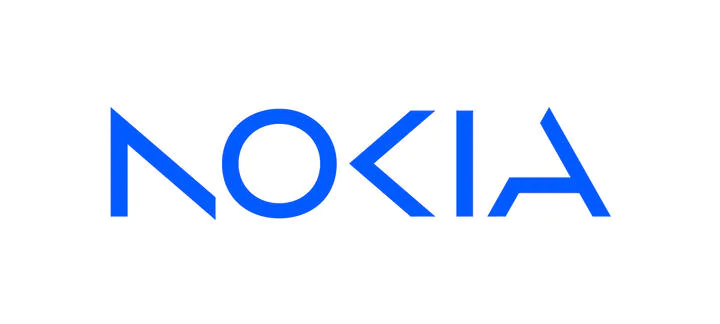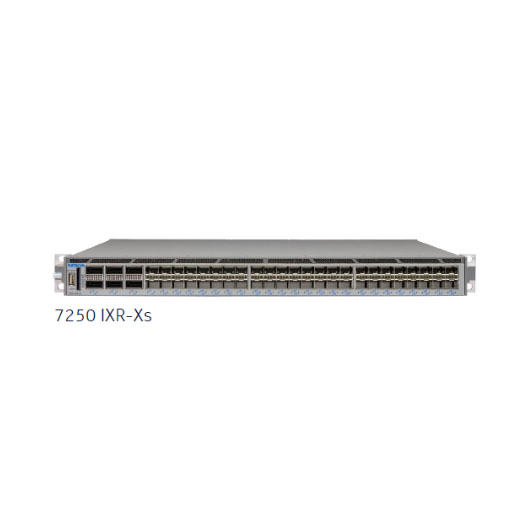Nokia 7250 IXR-Xs
Interconnect Router
The Nokia 7250 IXR-Xs routers are ideal as leaf nodes in data centers and multi-access edge computing nodes and are valuable for access and aggregation as well as 5G interconnectivity.
Nokia 7250 X Series Product Family
Nokia 7250 Interconnect Router-X series (IXR-X series) routers1 are high-speed, high-density 1RU platforms. They are ideal as leaf nodes in data centers and multi-access edge computing nodes and are valuable for access and aggregation as well as 5G interconnectivity.
There are three platforms in the IXR-X series: the 7250 IXR-Xs, 7250 IXR-X1 and 7250 IXR-X3. Using these routers, network operators can efficiently scale up bandwidth to prepare for future growth requirements.
Features & Benefits
- Routers in the Nokia 7250 IXR-X series provide up to 14.4 Tb/s of system capacity and are equipped with high-performance 400GE, 100GE, 50GE, 40GE, 25GE and 10GE interfaces, allowing networks to scale to meet evolving traffic demands. At only 1RU high, these compact routers provide high port density while minimizing rack space. They consume low watts per gigabit, and therefore provide ongoing cost savings.
- The 7250 IXR-X series uses a common fixedform design with options for port interfaces, power supplies and airflow that provide the versatility needed to fit a wide variety of network requirements. Redundant fans improve resiliency. These routers are ideal for carrier data center applications where their flexible port interfaces support layers of aggregation, for example, a first leaf layer of 25GE to 100GE aggregation and a second layer of 100GE to 400GE aggregation. Optical breakout options provide high-density 25GE and 10GE port counts and flexibility to mix connector types and port speeds.
- The 7250 IXR-X series combines low nodal latency with advanced synchronization features to serve latency-sensitive applications and meet 4G and 5G fronthaul requirements. Advanced QoS features allow high-priority packets to traverse the network without queuing delay. This makes them ideal for centralized and virtualized RAN applications, BBU aggregation and edge computing applications.
-
the 7250 IXR-X platforms enable model-driven network management features through the Nokia SR OS and are managed by the Nokia Network Services Platform (NSP). The Nokia NSP offers a rich set of service management features that automate new service delivery and reduce operating costs.
Standards-based software-defined networking (SDN) interfaces enable best-path computation to be offloaded to path computation elements (PCEs) such as the Nokia NSP. The 7250 IXR operates as a path computation client (PCC), collecting and reporting per-link and per-service delay, jitter and loss metrics, as well as port utilization levels, for efficient path computation.
High-density aggregation
Diverse applications
Low latency and accurate synchronization
Automation
Software Features
- Point-to-point Ethernet pseudowires/virtual leased line (VLL)
- Ethernet Virtual Private Network (EVPN)
- Virtual Private Wire Service (EVPN-VPWS)
- Virtual Private LAN Services (EVPN-VPLS): IPv4 and IPv6 support, including Virtual Router Redundancy Protocol (VRRP)
- Multihoming with single/active or active/active modes
- Multipoint Ethernet VPN services with VPLS based on Targeted Label Distribution Protocol (T-LDP) and Border Gateway Protocol (BGP)
- Routed VPLS with Internet Enhanced Service (IES) or IP-VPN, IPv4 and IPv6
- Ingress and egress VLAN manipulation for Layer 2 services
- IP VPN Virtual Private Routed Network (VPRN), Inter-Autonomous System (Inter-AS) Option A, B and C
- IPv6 VPN Provider Edge (6VPE)
- Segment routing
- Intermediate System-to-Intermediate System (SR-IS-IS) and Open Shortest Path First (SR-OSPF)
- Traffic engineering (SR-TE) IPv4, IPv6
- MPLS label edge router (LER) and label switching router (LSR) functions
- Label Distribution Protocol (LDP)
- Resource Reservation Protocol with traffic engineering (RSVP-TE)
- IP routing
- Dual-stack Interior Gateway Protocol (IGP) – Multi-topology, multi-instance Intermediate System-to-Intermediate System (IS-IS) – Multi-instance OSPF – Multiprotocol BGP (MP-BGP) – Accumulated IGP (AIGP) metric for BGP – BGP monitoring protocol(BMP) – BGP route-reflector for EVPN and IP-VPN with VPNv4 and VPNv6 address families (AFs) – BGP confederations – IGP and BGP shortcuts
Layer 3 Multicast – base routing
- Internet Group Management Protocol (IGMP)
- Multicast Listener Discovery (MLD)
- Protocol Independent Multicast – Sparse Mode (PIM-SM), Source Specific Multicast (SSM) for IPv4
- PIM-SSM for IPv6
- Layer 3 Multicast - VPRN
- Next-generation multicast VPNs (NG-MVPN)
- SSM with multicast LDPv4 (mLDPv4)
- IGMP/MLD
- IGMP/MLD on routed VPLS interface
- PIMv4/PIMv6
- Layer 2 Multicast
- IGMP/MLD snooping
- SR-TE LSPs, RSVP-TE LSPs
- PCC initialized, PCC controlled
- PCC initialized, PCE computed
- PCC initialized, PCE controlled
- SR-TE LSPs: PCE initialized, PCE controlled
- LSP stats
- Topology discovery: BGP-Link State (BGP LS)IPv4 and IPv6
- Telemetry: streaming interface statistics,service delay and jitter metrics
- Netflow/cflowd
- IEEE 802.3.ad Link Aggregation Group (LAG) and multi-chassis (MC) LAG
- Pseudowire and LSP redundancy
- BGP Edge and Core Prefix Independent Convergence (BGP PIC)
- Fast reroute:
- LDP with loop-free alternate (LFA) and remote loop-free alternate (rLFA) policies
- RSVP-TE
- Segment routing rLFA and topology independent LFA
- IP and MPLS load balancing by equal-cost multipath (ECMP)
- Weighted LAG hash
- VRRP
- Configurable polynomial and hash seed shift
- Entropy label (IETF RFC 6790)
- Ethernet IEEE 802.1Q (VLAN) and 802.1ad (QinQ) with 9k jumbo frames
- Detailed forwarded and discarded counters for service access points (SAPs) and network interfaces in addition to port-based statistics: per Virtual Output Queue (VoQ) packet and byte counters
- Dynamic Host Configuration Protocol (DHCP) server for IPv4 IES, VPNv4
- DHCP relay, IPv4 and IPv6, IES, IP-VPN, EVPN-VPLS
- Accounting records
- Hierarchical QoS
- Hierarchical egress schedulers and shapers per forwarding class, SAP, network interface, port or LAG
- Port sub-rate
- Granular rate enforcement with up to 32 policers per SAP/VLAN, including broadcast, unicast, multicast and unknown policers
- Hierarchical policing for aggregate rate enforcement
- Strict priority, weighted fair queuing schedulers
- Congestion management via weighted random early discard (WRED)
- Egress marking or re-marking
- Simple Network Management Protocol (SNMP)
- Model-driven (MD) management interfaces
- NETCONF
- MD CLI
- Remote Procedure Call (gRPC)
- Comprehensive management with Nokia NSP Operations, administration and maintenance
- IEEE 802.1ag, ITU-T Y.1731: Ethernet Connectivity Fault Management for both fault detection and performance monitoring, including delay, jitter and loss tests
- Ethernet bandwidth notification with egress rate adjustment
- ITU-T Y.1564 Service Activation Test
- IEEE 802.3ah: Ethernet in the First Mile
- Bidirectional Forwarding Detection IPv4 and IPv6
- Two-Way Active Measurement Protocol (TWAMP), TWAMP Light
- A full suite of MPLS OAM tools, including LSP and virtual circuit connectivity verification ping
- Service assurance agent
- Mirroring with slicing support:
- Port
- VLAN
- Filter output: Media Access Control (MAC), IPv4/IPv6 filters
- Local/remote
- Configuration rollback
- MAC-, IPv4- and IPv6-based access control lists
- Forward and drop statistics, local/remote logging
- Secure Shell (SSH) with configurable server/client lists and strong KEX, HMAC and CIPHERs
- AAA functionality with Remote Authentication Dial-In User Service (RADIUS), Terminal Access Controller Access Control System Plus (TACACS+), and comprehensive control-plane protection capabilities
- MAC-, IPv4- and IPv6-based access control lists
Each product model supports, but is not limited to, a variation of the following features. Please refer to 7210 SAS technical documentation for the features supported on each product
Services
Network protocols
SDN
Load balancing and resiliency
Platform
QoS and traffic management
System management
Security







